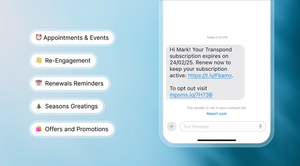Small business marketing can feel overwhelming, especially balancing social media, content creation and email campaigns.
With limited resources and a busy schedule, navigating all of the potential areas of small business marketing can feel extremely time-consuming.
So, it’s important to know that the key to success lies in well-defined small business marketing strategies. This means understanding your ideal customer, crafting a message that resonates with them, and using the right channels to build relationships and drive sales.
In this guide, we’ll show you how to identify who you’re trying to reach, develop a compelling message for your target audience, and use effective channels specifically suited to small businesses to nurture relationships and fuel sales growth.
We’ll also explore how technology can help you streamline your small business marketing, freeing up valuable time.
Building a strong marketing foundation
By taking the time to set clear goals, understand your target audience, develop a compelling brand identity and create a strategic content plan, you can lay the groundwork for attracting new customers, building relationships and ultimately driving sales.
Setting SMART goals
The first step to any successful marketing plan is setting clear and achievable goals. Forget vague aspirations of "increasing brand awareness" or "getting more sales."
Instead, embrace the power of SMART goals. SMART stands for Specific, Measurable, Achievable, Relevant and Time-bound.
Specific goals clearly define what you want to achieve. For example, instead of "get more website traffic," a SMART goal might be "increase qualified website leads by 20% within the next quarter."
Measurable goals allow you to track your progress. This could involve setting a target number of website sign-ups, social media followers or email subscribers.
Achievable goals are ambitious yet realistic considering your resources and budget.
Relevant goals align with your overall business objectives.
Finally, Time-bound goals establish a clear deadline for achieving your objective. By setting SMART goals, you can transform wishful thinking into a clear roadmap for marketing success.

Understanding your target audience
Market research allows you, as a small business owner, to gather valuable insights into your ideal customer’s demographics, needs, wants and buying behaviors.
This information can be gleaned from various sources, including online surveys, industry reports and even social media listening tools.
By segmenting your audience, you can further refine your target market. Try dividing your overall customer base into smaller groups with similar characteristics.
This allows you to tailor your marketing message and approach more effectively for each segment. For instance, a bakery might identify health-conscious millennials and busy professionals as two distinct customer segments.
Their marketing strategy for each group would likely differ, focusing on organic ingredients for the health-conscious crowd and convenient grab-and-go options for busy professionals.
Developing a buyer persona takes audience understanding a step further. Think of a buyer persona as a detailed profile of your ideal customer. It captures not just demographics, but also their challenges, goals and preferred communication channels.
By visualizing your ideal customer through a buyer persona, you can create targeted marketing campaigns that speak directly to their needs and pain points.
Developing your brand identity and value proposition
Your brand identity is the essence of your business – its personality, values and what makes it unique. A strong brand identity encourages trust and recognition with your target audience. To establish this, consider questions like ‘What makes your business stand out from the competition?’ and ‘What are your core values?‘.
Once you have a clear understanding of your brand identity, you can develop a compelling value proposition. This concise statement communicates the specific benefit your product or service offers to your target audience.
A powerful value proposition goes beyond simply describing your product or service. It focuses on the positive outcomes your offering helps customers achieve. For example, a company selling project management software might have a value proposition like ‘Increase team productivity and streamline collaboration with our user-friendly project management platform.’
Creating a content strategy
Content marketing is a powerful tool for attracting and engaging potential customers. By consistently creating valuable and informative content, you establish yourself as a thought leader in your industry and build trust with your audience.
The first step to a successful content strategy is developing a content calendar. This editorial calendar helps you plan and schedule your content creation, ensuring a consistent flow of fresh content across your chosen channels.
When it comes to content formats, the possibilities are many. Blog posts, articles, infographics and videos are all popular choices for small businesses.
The key is to choose formats that align with your target audience's preferences and the message you want to convey. For example, if you're targeting a visually oriented audience, creating high-quality videos or infographics might be a good strategy.
Remember, building a loyal audience takes time and consistent effort. The more valuable and informative your content is, the more likely you are to attract and retain potential customers.
By following these steps and building a strong marketing foundation, you can create a roadmap for success and unlock the full potential of your small business marketing efforts.
Mastering the marketing mix
For small businesses, especially in the B2B sector, effectively mastering the marketing mix involves balancing traditional marketing methods with modern digital strategies. This approach ensures broad coverage and engagement with your target market, and helps build meaningful industry relationships.
Making the most of traditional marketing channels
The rise of digital marketing doesn't negate the value of tried-and-tested traditional channels, especially in the B2B realm. Print advertising, for instance, can be highly effective when targeted through industry-specific publications read by key decision makers in your sector.
Trade shows offer another valuable avenue, providing a platform to demonstrate products, network, and generate leads in a focused environment. Additionally, a well-crafted public relations strategy can elevate a brand’s credibility and authority by securing coverage in respected business outlets.
Integrating these traditional methods involves aligning their messaging and objectives with your broader marketing strategy, ensuring each channel supports the others for cohesive brand storytelling.

Conquering digital marketing
With digital marketing, B2B businesses have a wealth of tools at their disposal, each serving distinct purposes within the marketing funnel.
Search engine optimization (SEO) is crucial as it enhances online visibility and draws organic traffic to your website by ensuring your content aligns with what your potential customers are searching for on search engines.
On the other hand, pay-per-click (PPC) advertising can quickly drive traffic and generate leads, providing an excellent complement to slower-burning SEO strategies.
Social media marketing in the B2B space tends to focus on platforms like LinkedIn, where businesses can engage directly with industry professionals, share insights and strengthen brand reputation.
Lastly, email marketing remains a staple, offering the ability to deliver personalized, relevant content directly to the inboxes of prospects and customers, nurturing leads through to conversion.
Building relationships through networking
Beyond channel-specific strategies, the essence of small business marketing often lies in relationship-building for small business owners.
Effective networking is vital, as it creates connections that could lead to partnerships, mentorship opportunities and new business. For offline networking, attending industry conferences and local business events presents opportunities to meet potential customers and influencers face-to-face, which can be invaluable in building trust.
Online, networking involves engaging on professional social platforms, participating in industry forums, and hosting webinars to share knowledge and connect with peers. Building a strong network requires consistency and genuine interaction, focusing on offering value to others as a way to nurture reciprocal relationships.
Remember, the marketing mix isn’t a one-size-fits-all approach. Experiment with different channels, track your results and adapt your strategy as needed. By strategically harnessing traditional and digital tactics, you can create a powerful marketing plan that drives growth for your small business.
Data-driven marketing for continuous improvement
Running a small business is a constant exercise in adaptation. By tracking key metrics and analyzing the information you gather, you can move beyond guesswork and make informed decisions that optimize your marketing efforts.
The key to data-driven marketing lies in identifying the metrics that matter most to your business. These will vary depending on your specific goals, but some metrics you may consider are website traffic, lead generation, conversion rates and social media engagement.
Once you've established your key metrics, choose the right tools to track them effectively. Many marketing automation platforms and analytics dashboards offer valuable insights into campaign performance.
Look for trends and patterns that emerge. Are certain marketing channels generating a higher return on investment than others? Is a specific type of content resonating more with your target audience? By identifying what's working well and what areas need improvement, you can make data-driven decisions to optimize your campaigns.
For instance, let's say your website traffic is booming, but your conversion rate remains low. This could indicate a user experience issue or a disconnect between your content and your target audience's needs. By analyzing your data, you can pinpoint the problem area and take corrective action to bridge the gap.
Marketing automation can be a game-changer in streamlining this process. These tools can automate repetitive tasks like email marketing campaigns and social media posting, freeing up your valuable time to focus on strategy and analysis.
Additionally, marketing automation platforms often provide built-in analytics dashboards, allowing you to track campaign performance and make data-driven decisions in real time. Regularly track your metrics, analyze the data, and adapt your strategy accordingly.
Streamlining your marketing operations
For small businesses, bandwidth is precious. This section looks at how project management, marketing technology (MarTech) and smart team structures can streamline your marketing operations and free up valuable time to focus on strategy and growth.
Project management for solopreneurs and small teams
Project management tools can be a game-changer for staying on top of your marketing activities.
This is because project management tools can break down large marketing projects into bite-sized, actionable tasks. Assign deadlines and team members, ensuring everyone's on the same page.
They also keep a pulse on project progress. Identify potential roadblocks early on and adjust course as needed to stay on track and meet deadlines.
These tools also aid in facilitating seamless communication and collaboration. Share documents, updates and feedback within your team, keeping everyone in the loop.
Consider user-friendly project management tools like Capsule, Asana or Trello. They offer free plans with features specifically designed for small teams. By implementing these tools effectively, you can streamline workflows, boost your productivity, and deliver impactful marketing campaigns without feeling overwhelmed.
MarTech on a Budget
Marketing technology (MarTech) might sound intimidating for small businesses, but it doesn't have to be. Many affordable MarTech solutions exist to automate tasks, improve ROI and gain valuable customer insights.
Many customer relationship management (CRM) platforms offer free plans, or free or low-priced tiers with features like contact management, lead nurturing and basic email marketing automation. These tools can centralize your customer data and automate repetitive tasks, freeing up your time to focus on building relationships.
Tools like Transpond, Hootsuite, and Buffer have free plans that allow you to schedule social media posts in advance, track brand mentions and engage with your audience. This ensures consistent brand messaging across your social media channels, even if you don't have time to post every day.
Platforms like Mailchimp offer free plans with email marketing automation features. Create targeted email campaigns, personalize messages and set up automated lead nurturing sequences. This allows you to nurture leads effectively and convert them into paying customers without needing a dedicated marketing automation specialist.
By experimenting with these essential MarTech tools, you can achieve greater efficiency and effectiveness in your marketing efforts, even with a small team or limited budget.
Building a small, skilled marketing team
Even a small, skilled marketing team can make a world of difference for your small business.
Make sure to set aside time to learn the latest marketing trends and tools. Take online courses, attend webinars, or join industry groups to stay ahead of the curve.
Consider outsourcing specific tasks to freelancers or virtual assistants. This allows you to tap into specialized skills and free up your time to focus on your core strengths.
If you have a small internal team, delegate tasks based on individual strengths and interests. Trust your team members to take ownership and make informed decisions within their area of responsibility.
By treating yourself like a team of one and creating a culture of continuous learning and strategic outsourcing, you can achieve impressive marketing results even with limited resources. Remember, a small but focused marketing effort can be just as effective as a larger team, if not more so.
Putting it all together
So, you now have your marketing bearings, you're fired up to try some advanced techniques, and you've got a toolbox overflowing with resources. Below are some practical steps to bring it all together, from creating a roadmap to measuring success.

Create a roadmap
Think of a roadmap as a visual strategy. It helps you plan campaigns in advance, schedule content creation, and ensure a consistent flow of social media posts to keep your audience engaged.
Block out important industry events, product launches and key dates to ensure everything stays on track. Be realistic about your workload - don't overload your calendar or you'll find yourself missing deadlines and feeling overwhelmed.
Allocate resources wisely
Start by reviewing your business goals and identifying the marketing channels that best align with them. This will help you allocate your resources strategically.
Prioritize channels that have historically generated a good return on investment for your business. Begin with a realistic budget and track your results closely.
As you see success with specific channels, you can gradually allocate more resources. Remember, there are many free and affordable marketing tools available, so take advantage of them to maximize your budget.
Ensure consistent messaging
An uncoordinated marketing strategy feels like shouting multiple messages through a dozen different megaphones. For maximum impact, your marketing channels need to work together seamlessly, presenting a unified brand message across all channels.
Ensure your messaging, visuals and overall brand identity remain consistent across your website, social media platforms and email marketing campaigns.
Promote your blog posts on social media, mention upcoming webinars in your email marketing campaigns, and use every opportunity to connect the dots between your different marketing channels. Tracking and analyzing how different channels work together is vital.
This allows you to identify areas for improvement and optimize your overall marketing strategy for better results.
Adapting your approach based on results
The true power of marketing lies in regularly measuring the effectiveness of your campaigns and adapting your approach based on the data.
Don't be afraid to ditch what's not working. If a specific marketing channel isn't delivering results, adjust your budget or try a different approach. For example, maybe your social media strategy isn't resonating - if so, experiment with different content formats or explore a new platform altogether.
Try to embrace a culture of continuous improvement. Use your data to identify what's working well and what needs tweaking.
Remember, flexibility based on empirical evidence is key to improving your marketing effectiveness over time. By consistently implementing the strategies outlined in this guide, measuring your results, and adapting your approach, you'll be well on your way to achieving your marketing goals.
Small business marketing with Capsule and Transpond
You can gain valuable insights into small business marketing performance with Capsule and Transpond. With an array of data, you’ll be able to edit and optimize campaigns, maximize ROI, and refine your small business marketing strategy.
All in all, Capsule CRM streamlines your small business marketing and helps you nurture stronger customer relationships. Sign up for a free trial of Capsule CRM today and watch your small business thrive.
Frequently Asked Questions
There's a whole world of possibilities beyond online marketing. Partner with local businesses in complementary industries for cross-promotion.
Offer exclusive discounts to residents in your area to attract new customers. Sponsor a local event to increase brand awareness and show community engagement. Or host a workshop to establish yourself as an expert, and create a loyalty program to reward repeat business.
The most important metrics depend on your goals. If it's attracting new customers, focus on website traffic and lead generation.
Building brand awareness? Track social media engagement and reach. Conversion rate is crucial – it measures the percentage of website visitors who take a desired action (like buying something).
Absolutely! Industry events offer a wealth of benefits. Network with potential partners and clients, learn about the latest trends and challenges in your field and gain valuable knowledge from industry experts through workshops and presentations. Look for events focused on your specific industry to maximize the value.
Several strategies can boost conversions. Ensure your website is mobile-friendly and easy to navigate. Use clear calls to action that tell visitors what you want them to do (e.g., "Contact Us").
Optimize your website content for relevant keywords to improve search engine ranking. Consider offering incentives like free consultations or discounts to encourage visitors to take action
Content marketing is a powerful tool. Start by identifying your target audience's needs and interests. There are many content formats to choose from – blog posts, articles, infographics or even videos.
Focus on providing valuable information, not just selling your products or services. Maintain a consistent publishing schedule and promote your content across various channels to attract and engage potential customers.




